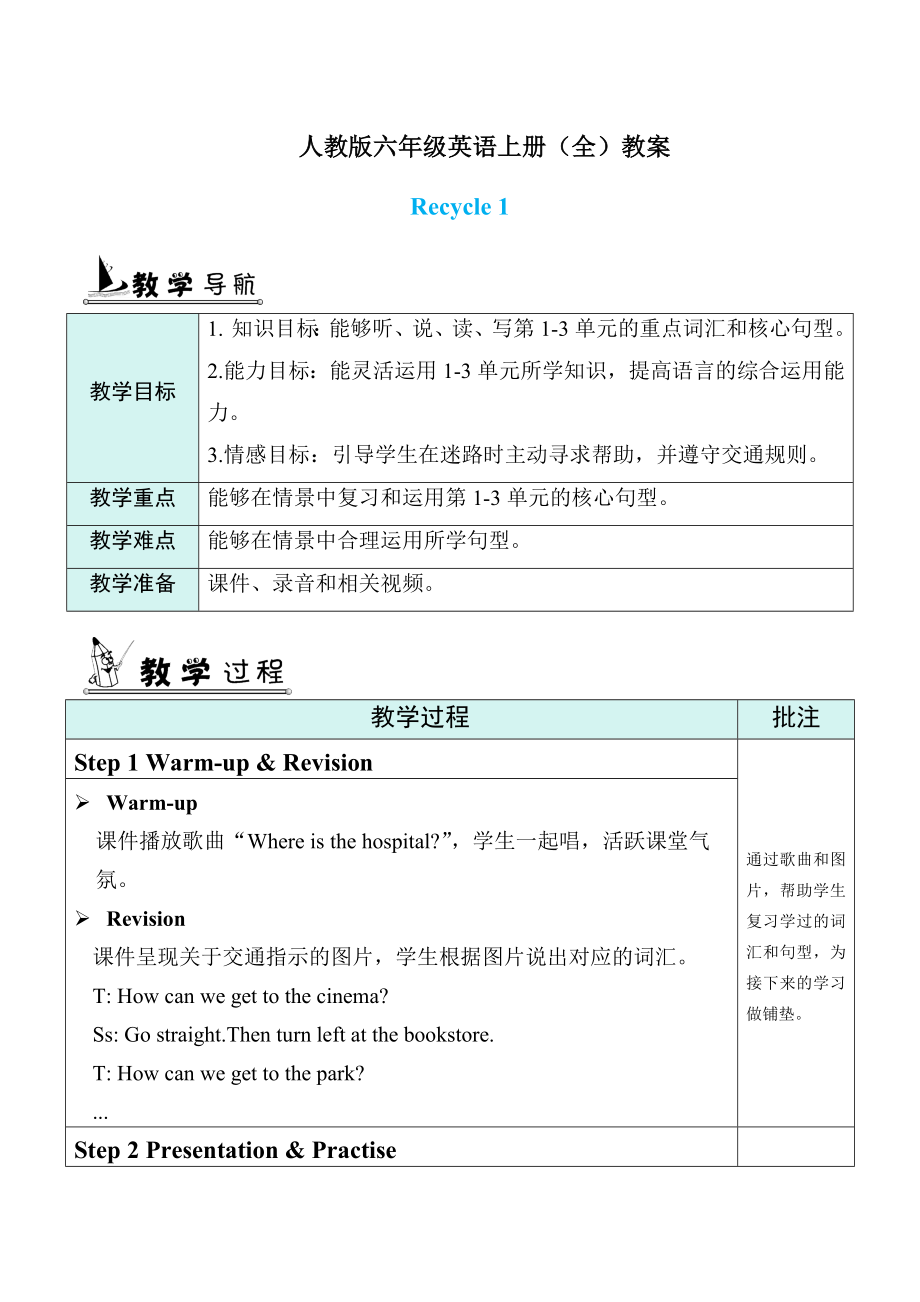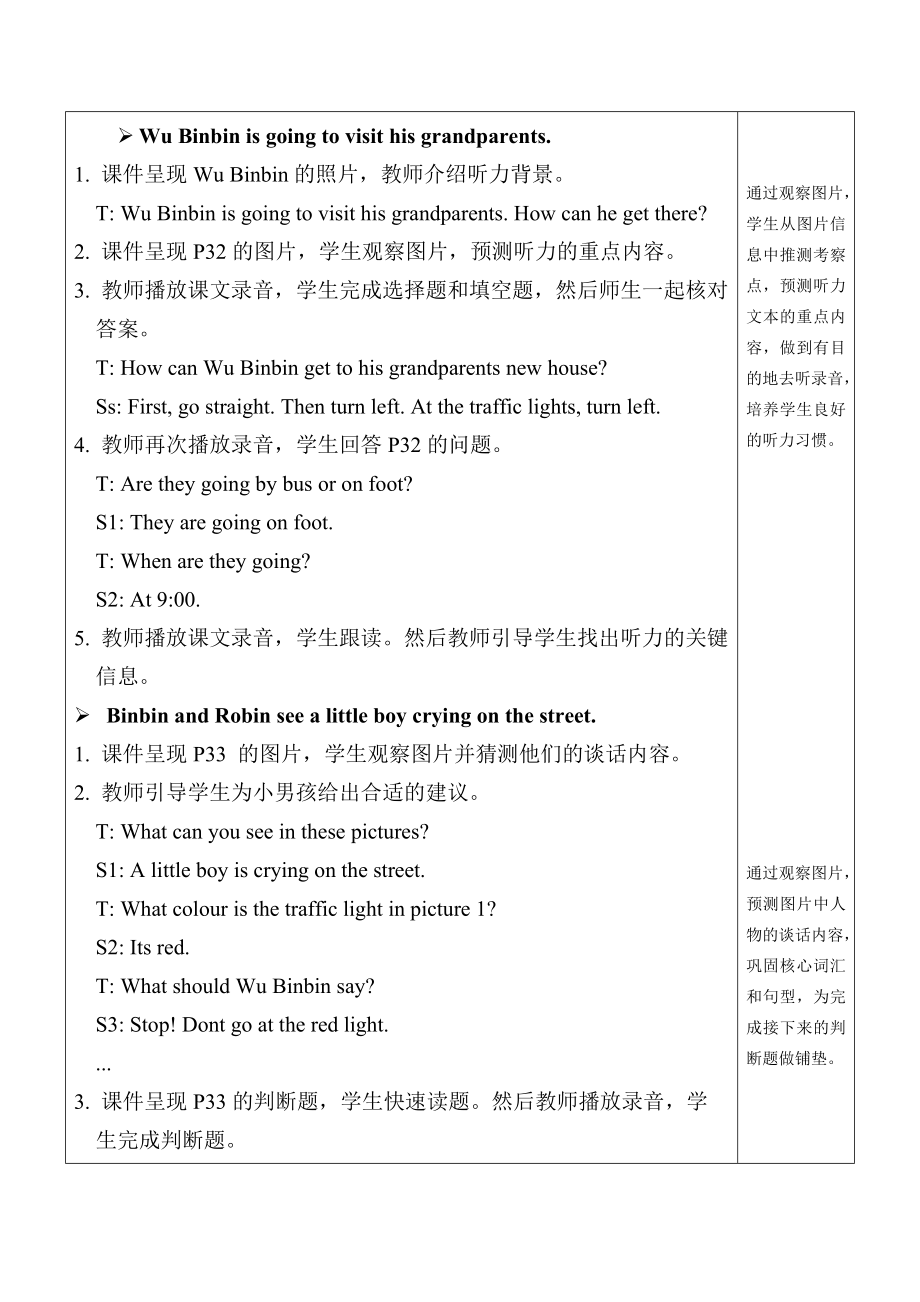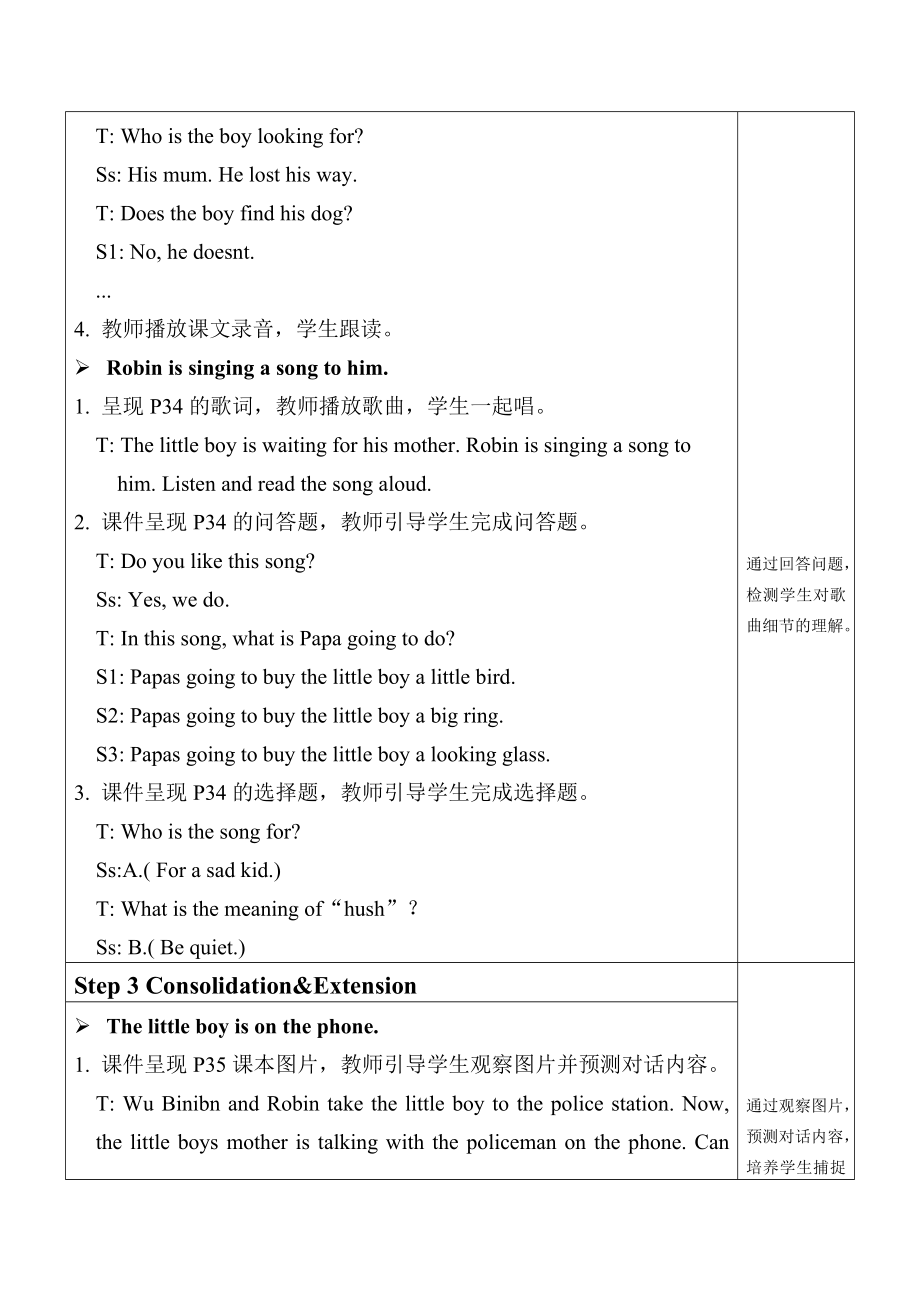 2023年秋人教PEP版六年级上英语全册教案
2023年秋人教PEP版六年级上英语全册教案
《2023年秋人教PEP版六年级上英语全册教案》由会员分享,可在线阅读,更多相关《2023年秋人教PEP版六年级上英语全册教案(150页珍藏版)》请在七七文库上搜索。
1、人教版六年级英语上册(全)教案Recycle 1教学目标1. 知识目标:能够听、说、读、写第1-3单元的重点词汇和核心句型。2.能力目标:能灵活运用1-3单元所学知识,提高语言的综合运用能力。3.情感目标:引导学生在迷路时主动寻求帮助,并遵守交通规则。教学重点能够在情景中复习和运用第1-3单元的核心句型。教学难点能够在情景中合理运用所学句型。教学准备课件、录音和相关视频。教学过程批注Step 1 Warm-up & Revision通过歌曲和图片,帮助学生复习学过的词汇和句型,为接下来的学习做铺垫。 Warm-up 课件播放歌曲“Where is the hospital?”,学生一起唱,活跃
2、课堂气氛。 Revision课件呈现关于交通指示的图片,学生根据图片说出对应的词汇。T: How can we get to the cinema?Ss: Go straight.Then turn left at the bookstore. T: How can we get to the park?.Step 2 Presentation & Practise通过观察图片,学生从图片信息中推测考察点,预测听力文本的重点内容,做到有目的地去听录音,培养学生良好的听力习惯。通过观察图片,预测图片中人物的谈话内容,巩固核心词汇和句型,为完成接下来的判断题做铺垫。通过回答问题,检测学生对歌曲细节
3、的理解。 Wu Binbin is going to visit his grandparents.1. 课件呈现Wu Binbin的照片,教师介绍听力背景。T: Wu Binbin is going to visit his grandparents. How can he get there?2. 课件呈现P32的图片,学生观察图片,预测听力的重点内容。3. 教师播放课文录音,学生完成选择题和填空题,然后师生一起核对 答案。T: How can Wu Binbin get to his grandparents new house? Ss: First, go straight. Then
4、 turn left. At the traffic lights, turn left. 4. 教师再次播放录音,学生回答P32的问题。T: Are they going by bus or on foot?S1: They are going on foot.T: When are they going?S2: At 9:00.5. 教师播放课文录音,学生跟读。然后教师引导学生找出听力的关键 信息。 Binbin and Robin see a little boy crying on the street.1. 课件呈现P33 的图片,学生观察图片并猜测他们的谈话内容。2. 教师引导学生
5、为小男孩给出合适的建议。T: What can you see in these pictures?S1: A little boy is crying on the street.T: What colour is the traffic light in picture 1?S2: Its red. T: What should Wu Binbin say?S3: Stop! Dont go at the red light.3. 课件呈现P33的判断题,学生快速读题。然后教师播放录音,学 生完成判断题。T: Who is the boy looking for? Ss: His mum.
6、 He lost his way.T: Does the boy find his dog? S1: No, he doesnt. .4. 教师播放课文录音,学生跟读。 Robin is singing a song to him.1. 呈现P34的歌词,教师播放歌曲,学生一起唱。T: The little boy is waiting for his mother. Robin is singing a song to him. Listen and read the song aloud.2. 课件呈现P34的问答题,教师引导学生完成问答题。T: Do you like this song
7、?Ss: Yes, we do.T: In this song, what is Papa going to do? S1: Papas going to buy the little boy a little bird. S2: Papas going to buy the little boy a big ring.S3: Papas going to buy the little boy a looking glass.3. 课件呈现P34的选择题,教师引导学生完成选择题。T: Who is the song for?Ss:A.( For a sad kid.)T: What is th
8、e meaning of“hush”?Ss: B.( Be quiet.)Step 3 Consolidation&Extension通过观察图片,预测对话内容,培养学生捕捉关键信息的能力。通过角色扮演,提高学生的英语表达的积极性,培养学生的语言综合运用能力。 The little boy is on the phone.1. 课件呈现P35课本图片,教师引导学生观察图片并预测对话内容。T: Wu Binibn and Robin take the little boy to the police station. Now, the little boys mother is talking
9、with the policeman on the phone. Can you guess what they are talking about?2. Look at the map and fill in the blanks. 课件呈现地图和习题,学生根据地图完成填空题。T: The little boys mother is going to the police station to find her son. How she can get to the police station?Ss:3. Read, answer and do.课件呈现习题,学生完成练习并列举出更多的交通
10、方式。T: How can the boys mother go to the police station?Ss: On foot. T: What other kinds do you know? Ss: By bike.4. Listen and read aloud.A. 教师播放音频,学生跟读。B. 教师请学生上台表演对话并教导学生在迷路时要寻求警察的帮助。Step 4 Homework作业:1. 复习1-3单元重点单词和句型。2. 完成本课时对应的练习。板书设计Recycle 1Where is . It s next to/ near.How can I get to. Turn
11、 left. Turn right. Go straight.How do you go to. By. On foot.What are you going to do? Im going to.教学反思本课时以练习和阅读为主。要求学生能够运用所学的知识完成练习;借用图片、语言等帮助学生读懂故事,并通过不同的练习训练学生在语篇中捕捉关键信息的能力。同时教导学生要遵守交通规则,在迷路时要积极寻求帮助。Recycle 2教学目标2. 知识目标:能够听、说、读、写第4-6单元有关业余爱好、职业、情绪的单词,词组和核心句型。2.能力目标:能灵活运用4-6单元所学知识,提高语言的综合运用能力。3.情感
12、目标:教育学生诚实守信,使学生了解到诚实是最宝贵的品质。教学重点能够在情景中复习和运用第4-6单元的核心句型。教学难点能够在情景中合理运用所学句型。教学准备课件、录音和相关视频。教学过程批注Step 1 Warm-up & Free talk通过呈现图片,帮助学生复习学过的词汇和句型,提高学生学习兴趣,并为接下来的学习做铺垫。 Warm-up 课件播放歌曲“My new pen pal”和“What do you want to be?”,学生一起唱,活跃课堂气氛。 Free talk1. 课件呈现一组关于职业的图片,学生说出对应的单词。 ( postman, fisherman, coach
13、, scientist, pilot, businessman, factory worker, police officer) T: Whats your fathers job? Ss: He is a. T: Whats your mothers job? Ss: She is a .T: What do you want to be? Ss: I want to be a/an.2. 课件呈现一组关于爱好的图片,学生说出爸妈及自己的爱好。T: What does your father/mother like to do? What are their hobbies?Ss: My f
14、ather likes. My mother likes.T: What are your hobbies?Ss: I like. Step 2 Presentation & Practice通过观察图片,学生从图片信息中推测考察点,预测听力文本的重点内容,做到有目的地去听录音,培养学生良好的听力习惯。通过观察图片,引导学生描述人物情绪和动作,巩固核心词汇和句型,提高学生的语言综合运用能力。1. Listen and fill in the blanks.A. 课件呈现Peter的照片,导入新课。T: Do you still remember Peter? Ss: Yes, he is Zh
15、ang Pengs pen pal.T: Peters family are going to visit Kens family in another town. Peters father is talking about them. (T points to Kens photo.)T: This is Ken. Lets learn about Kens family.B. 课件呈现P66第一部分的填空题,学生先读题,预测听力的重点内容。T: How many people are there in Kens family? Who are they?Ss: .T: What do t
16、hey do? What are their jobs?C. 播放课文录音,学生完成填空题,然后师生一起核对答案。2. Listen again and write down their hobbies.A. 课件呈现P66 Lets check板块的第二部分的习题,学生快速读题并预测答案。B. 播放听力,学生完成习题,然后师生一起核对答案。C. 再次播放听力,学生跟读。3. Talk about Peters family.A. 呈现P67 Peter家庭的照片,教师引导学生观察图片。T: Peters family are on the bus. What are they doing o
17、n the bus?How do they feel?(T points to Peters father in the picture. )T: Who is he? Ss: Hes Peters father.T: What is he doing? Ss: Hes talking.T:How does he feel? Ss: He is happy.B. 根据P67 Zip的提示,学生描述图中不同人物的动作和情绪。C. 教师引导学生完成字谜游戏。T:Peter is doing word puzzles on the bus. This is Peters puzzle. He thi
18、nks its too difficult . Lets help him finish it.Step 3 Consolidation&Extension通过讲解种花的过程,为阅读扫清部分词汇障碍,顺利地过渡到故事的教学,为接下来的学习做铺垫。引导学生总结故事的构成要素并根据故事的构成要素复述故事,培养学生的语言综合运用能力。 Story time1. 课件呈现一张小女孩种花的图片,教师引导学生思考种花的过程。T: Whats she doing? Ss: She is planting flowers.T: Do you know how to plant flowers? Lets le
19、arn it.2. 学生快速浏览故事,然后找出故事中的人物。T: How many people are mentioned in the story? Ss: 4.T: Who are they?Ss: A rich old businessman, a factory worker, a coach and a fisherman.3. Read and answer.A. 学生快速浏览四个问题,预测故事重点内容。B. 学生阅读故事后回答问题。C. 教师引导学生在故事文本中找出关键信息并核对答案。Q1: Who can get the businessmans money?Q2: What
20、 do three men bring?Q3: Who gets the businessmans money?Q4: Why does the fisherman get the money?D. 播放故事音频,学生跟读。4. Read again and answer.A. 学生再次阅读课文,然后完成课本P68的两道习题。B. 教师引导学生理解句子“People should be honest.”并教育学生要 诚实守信。5. Retell the story.A. 教师引导学生总结故事的构成要素。T: Peter likes the story very much. He is goin
21、g to tell it to his best friend. Lets take a look at the elements of a story.T: A story often has a setting (when and where), characters (who) and a plot (what happens). Fill in the blanks for this story.B. 学生完成P69的填空题。C. 根据图片和句子的提示,学生尝试复述故事。D. 教师请学生代表扮演成Peter复述故事。Step 4 Homework作业:1. 复习4-6单元重点单词和句型
22、。2. 完成本课时对应的练习。板书设计Recycle 2How to write a story?When: Where:Who: What happens:教学反思本课时以练习和阅读为主。要求学生能够运用所学的知识完成练习;借用图片、语言等帮助学生读懂故事;通过练习训练学生在语篇中捕捉关键信息的能力,并渗透诚实守信的价值观。Unit 1 How can I get there?第一课时Part A Lets learn & Make a map and talk教学目标1.知识目标:能熟练掌握词汇science museum, post office, bookstore, cinema和h



- 配套讲稿:
如PPT文件的首页显示word图标,表示该PPT已包含配套word讲稿。双击word图标可打开word文档。
- 特殊限制:
部分文档作品中含有的国旗、国徽等图片,仅作为作品整体效果示例展示,禁止商用。设计者仅对作品中独创性部分享有著作权。
- 关 键 词:
- 2023 年秋人教 PEP 六年级 英语 教案
 七七文库所有资源均是用户自行上传分享,仅供网友学习交流,未经上传用户书面授权,请勿作他用。
七七文库所有资源均是用户自行上传分享,仅供网友学习交流,未经上传用户书面授权,请勿作他用。



 浙公网安备33030202001339号
浙公网安备33030202001339号
链接地址:https://www.77wenku.com/p-249412.html